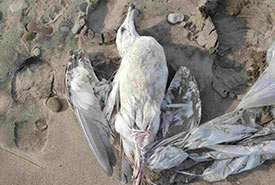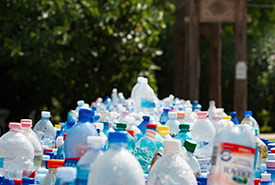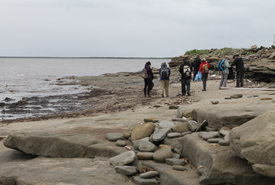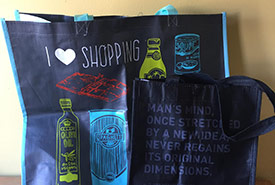Reduce your plastic footprint

Gull with balloon ribbon wrapped around its feet (Photo by Jason Read)
On World Environment day this past June 5, the United Nations (UN) called for the end of single-use plastic. Using the #beatplasticpollution hashtag, there were all kinds of conversations on Twitter about how to minimize your plastic use.
Plastic takes significant amounts of energy to create. It doesn’t decompose, which makes it a huge environmental issue, especially for our oceans. It is all too common for birds and other animals like sea turtles to die from eating plastic. And because plastic never entirely breaks down, lots of that plastic stays in the food chain; some of it even ends up in the food we eat. I wanted to share some of the top tips from the UN and the Nature Conservancy of Canada for trying to reduce your plastic footprint.
1. Do a plastic audit

Do a plastic audit at home or at your workplace to find out how big your plastic footprint is. (Photo by Pexels, CC0)
What does that mean? It means collecting all of your plastic use for a set period of time. I suggest at least two weeks so you get a shopping trip or two in during that time. Then count all of the plastic that you have amassed so you can know how big your plastic footprint is. One idea is to gather all of the plastic so that you can have a visual for how much plastic you use. You can then set a goal to cut back and consume less of it. It is amazing how many bags, containers and other plastic objects you only use once. Set a goal that is realistic but meaningful.
This is also a fun thing to do in your workplace. After discovering how much plastic your workplace uses, set goals as a team and maybe even have prizes for successfully reaching your goal.
2. Ditch the single-use plastic water bottle
If you haven’t already invested in a good reusable water bottle, it is the easiest way to cut your plastic consumption. By drinking out of a reusable water bottle you are not only helping to keep plastic out of the landfill and ocean, you are also saving money in the long run.
Reusable water bottles are in style right now too. They come in all shapes and sizes, but it seems like bright colours and patterns are very stylish at the moment. Get with the trend and get a reusable water bottle.

CV beach clean up event in Escuminac, NB (Photo by NCC)
3. Do a plastic cleanup
Many of our Land Lines readers love to walk and hike in nature. The next time you go for a hike, take a garbage bag and fill it with any trash that you find along the trail. We recommend taking plastic gloves or a trash grabbing stick. You only have to go once or twice to see a noticeable difference in your local trail, especially in the city.
My parents do this every spring at their favourite park. One walk through the park with a garbage bag in May means the walk will be more beautiful for the rest of the summer.
You can also see if NCC is doing a cleanup in your area. Check it out here.
Invite some friends and have a competition to see who can pick up the most garbage. You would be surprised how much fun this can be!
4. Avoid pre-made food when possible
Many groceries stores now stock ready-to-eat meals that almost always come in plastic containers. Soups, salads, sushi or sandwiches are often over-packaged in plastic. We are all busy people who sometimes want a quick meal, but you can significantly reduce your plastic use by buying fresh fruits and veggies that aren’t over packaged in plastic. Ask for them wrapped in paper if you can.

Reusable shopping bags (Photo by Raechel Bonomo/NCC staff)
5. #Banthebag
Start saying "no" to plastic grocery bags, and bring your own reusable cloth bags. Plastic bags are almost indestructible in nature and are easily carried by the wind. It is no wonder our oceans are becoming clogged with them. Bringing a reusable shopping bag helps lessen the number of bags ending up in nature.
It has become a global movement to avoid single use plastic bags at grocery stores. Many cities, like Montreal, have gone so far as to ban them altogether. The hashtag #banthebag has become the unofficial slogan of refusing to use single-use plastic bags.
Anything beats single-use plastic bags, but if you really want to be an eco-friendly shopper, use the multi-use polyurethane bags that are sold at most grocery stores. These bags take less energy to create than standard canvas bags, which makes them more carbon friendly.
#Beatplasticpollution
Hopefully these helpful tips will help you try to do your part. Together we can beat plastic pollution.
The Conservation Internship Program is funded in part by the Government of Canada’s Summer Work Experience program.


